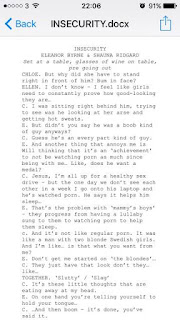Reader 1 on Professional Communication Technologies explores the use of social networking in the workplace. Already I have outlined my use of Web 2.0 alongside my professional acting career. The idea of remixable data and transformations relates directly to usage of Web 2.0 forums such as
https://www.dropbox.com/ and
https://wetransfer.com/ where I can share my acting material and screen reels with my agents or casting directors. The Bruns' theory that we are both the producer and consumer of the media shared online is relevant in this case. Once I have shared a clip openly with someone else - it is in their hands to edit and amend how they want. This process of 'produsage' claims that 'artefacts generated are no longer products in a traditional sense: they are always unfinished, and continually under development'. In the scenario when I open a self-tape up to a critical consumer - produsage comes to the forefront of my mind. My clip is open to be subjected to being edited by the consumer by means of software on their personal devices.
Privacy is an ethical issue that may occur alongside produsage. I am more than happy to allow my personal media to be developed by my agents and so forth - however, I would hate to think that this footage would ever land in unsavoury hands. This is where the privacy settings during the sending process of footage becomes important. Dropbox, WeTransfer and YouTube all contain privacy settings on media that I share. Dropbox actually offers the use of a specific password where only people who know this password can access the material. I find this, alongside the private view setting on YouTube, really handy for my audition material. Regardless of 'unsavoury hands' finding the footage; I also don't want any of my footage to be on public display until it has been cleared and edited by my agents. This relates back to the importance of how we present ourselves as actors on Web 2.0 forums. In task 1c we are asked to use YouTube as a medium to record an audio-visual summing up our experience of the course so far. My experience with YouTube as a Web 2.0 platform will assist me on this task - as will my experience self-taping, to get a good set-up on my filming.
Reader 1 also discusses harnessing collective intelligence on Web 2.0 platforms. Gruber uses Facebook as an example of this mass communication. I would like to add that I find out a lot of recent current affairs first and foremost from Facebook. Facebook users are so quick on the mark at sharing tragic or amazing events that have occurred. Statistically this makes perfect sense - If you sum up the sheer amount of people who have access to write an opinion / share an event or update a status at the touch of a button; then of course the news I hear about is most likely to come from this forum of Web 2.0.
However, an interesting slant which dawned on me whilst reading Reader 1 was that Instagram is probably the biggest gathering of visual collective intelligence. We are slandered with thousands of instant images daily on Instagram - many of these specially honed to our own interests (a part of Web 2.0 intelligence which is expanding all the time). A particular sector of the Instagram Web 2.0 collective intelligence sector which I find ever-expanding is the health & fitness section. I am forever flooded with healthy food inspiration and various work-out ideas on Instagram. This is a positive reinforcement of collective intelligence - and I believe harnessing it in a visual manner reaches out instantly to the masses.
On a personal level - I use Instagram as an architecture of participation and platform to present myself, my thoughts and my vision.
Another lightbulb which sprang into action whilst reading Reader 1 was how I take the freedom of online participation completely for granted. All of the Web 2.0 forums which I use are totally free. This allows the age-old freedom of speech right to be developed by the individual who chooses to use their social media as platforms for their practice.
Most recently, I set up a Facebook group for the students of BAPP starting in Spring 2017. This is to allow us to share ideas, discuss problems and to use as a general forum to stay in touch throughout the modules.
'Web 2.0 advocates that through reducing these barriers and making participation cheap, easy and quick, people are more able to get involved in the processes of collaboration, sharing and interaction.'
- Reader 1, Middlesex University 2016 ©, p.4
This is a perfect quote from Reader 1 which highlights the reason why I started up the BAPP Facebook group.
I will continue to explore the ideas, theories and issues raised in Reader 1 in my blogs, including ethical considerations. I want to read more on the subject from other sources and continue to blog about professional communication technologies.
'L'internet rend le monde un petit village'
- TR. 'The Internet makes the world a little village'





















